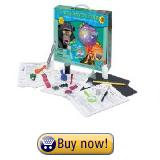Science Projects For Kids
Science projects for kids are fun. Science is present everywhere in our world and science activities can help kids better understand the world surrounding them. Science activities can also spark an interest in science. Being naturally very curious, science can fuel children's curiosity. In the process, it can also teach them skills that they will be able to later use at school. Science activities can also ignite a passion in children and lead them to future career choices. Sometimes passions start in elementary school!
Science activity 1: Track the Rainfall (Ages 8-9)
We like science projects for kids that teach kids to collect information and data, create charts, and that can even develop a passion for knowledge and science.Instructions:
- Get a glass jar, a marker, a ruler and a calendar.
- Have your child place the rule next to the side of the glass jar and make a line with the marker every half-inch from the botton of the glass to the top.
- Your kid has now created a rain gauge! Place the rain gauge outside (in your garden or in your balcony) so that it can collect the rainfall.
- Use the calendar to track the rainy days. For each rainy day use the gauge to measure the rainfall amount. For non rainy days put a "0" on any non rainy day.
- Create a chart with on the X axis the day and on the Y axis the inches of rain. Update the chart on a daily, weekly, or monthly basis!
- Soon your child will realize that there is more rain in the Spring than in the Summer and will be able to measure the difference!
Benefits: this activity can teach your kid to collect and analyze data which is the basis of any scientific method. Your kid learns to work with numbers, draw conclusions. He also acquires a taste for science.
Build a Barometer (Ages 7-9)
Science projects for kids can turn your kid into a scientist and an engineer, become a physical science lesson and enhance your kid's observational skills. In this activity, your little scientist will build a barometer and learn about weather conditions.Instructions:
- Get a pair of scissors, a rubber band, two straws, a toothpick, a balloon, a jar, a ruler, a marker, a sheet of paper, a pen and tape!
- Cut the neck off the balloon. Take the remaining piece of the balloon and stretch it across the jar. Seal it with the rubber band around the rim of the jar.
- Tape the two straws together in order to make one longer straw.
- Tape the toothpick to one end of the long straw. The toothpick is now an indicator needle!
- Tape the other end of the long straw to the center of the balloon so that it sticks out about 5-6 inches from the bottle.
- On the sheet of paper, mark quarter-inch increments (1, 1 1/4, 1 1/2, 1 3/4, 2, etc) from the bottom of the paper to the top.
- Tape the sheet of paper, on a wall, position the barometer so that the indicator needle points to the number near the middle of the chart.
- Have your child record the date, the weather, and the number the indicator needle points to.
Have him analyze the data by creating a chart. Your kid will discover a pattern between the type of weather and the barometer reading. When the air pressure is high (hot weather), the balloon will push the straw up and the needle will indicate higher numbers on the chart. When the air pressure is low (rainy weather), the needle will indicate lower air pressure numbers.
Benefits: Science projects for kids can teach your kid to work on science projects for kids, build barometer, and analyze data!

 If you are looking for science kits that can help your kid build a barometer, we recommend the award-winning Young Scientist Series. It includes 3 kits in one box, children can build a weather station with a barometer, wind vane, rain gauge and thermometer. The Young Scientist Series has won: the National Parenting Center Seal of Approval, Learning Research Institute Outstanding Resource Award, the National Parenting Publications Honors Award, the Learning Magazine 2004 Teachers’ Choice Award and the Practical Homeschooling Reader Award! The kits were designed by a team of Harvard graduates, scientists and educators with the purpose to combine fun with learning in each and every product. These kits can really spark your kid's interest in science, that's why we highly recommend them.
If you are looking for science kits that can help your kid build a barometer, we recommend the award-winning Young Scientist Series. It includes 3 kits in one box, children can build a weather station with a barometer, wind vane, rain gauge and thermometer. The Young Scientist Series has won: the National Parenting Center Seal of Approval, Learning Research Institute Outstanding Resource Award, the National Parenting Publications Honors Award, the Learning Magazine 2004 Teachers’ Choice Award and the Practical Homeschooling Reader Award! The kits were designed by a team of Harvard graduates, scientists and educators with the purpose to combine fun with learning in each and every product. These kits can really spark your kid's interest in science, that's why we highly recommend them.
Some of the activities ideas on this page have been graciously submitted by visitors like yourself. If you have tried our science activities and you want to submit a comment or if you have a science activity idea, don't hesitate to share your experience here. We will review it and you'll be taking part in creating the web's ultimate resource for activities ideas that both parents and children can enjoy.
Return from Science Projects for Kids to Recreational Activities for Kids
Return from Science Projects for Kids to Homepage